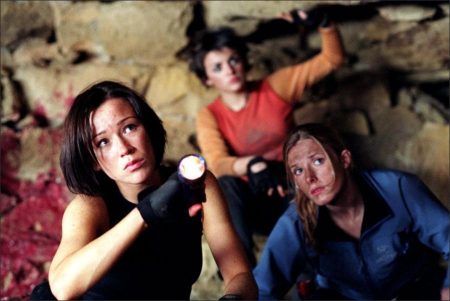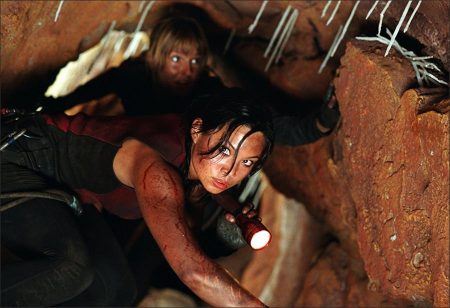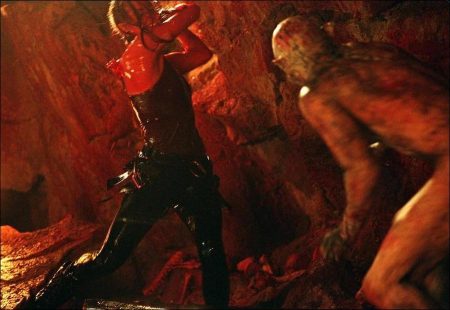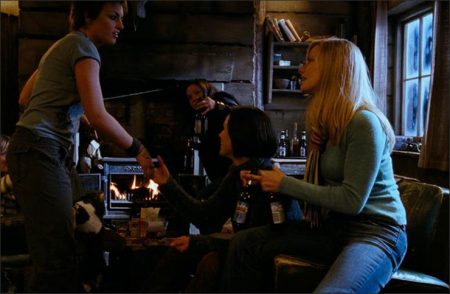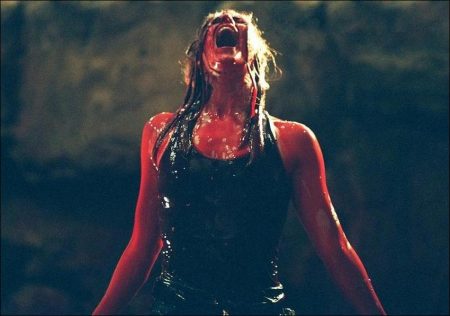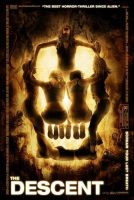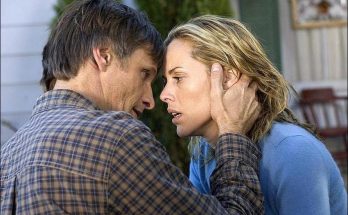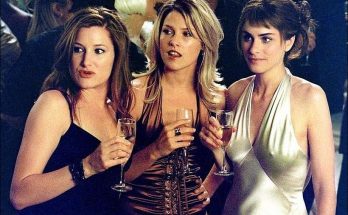Tagline: Face your deepest fear.
In a remote mountain range, six girlfriends meet for their yearly adventure, a caving trip into the arteries of the earth. The group makes their way through the remote cave system, enjoying the hazardous but beautiful surroundings. Then, deep inside the cave, disaster strikes when their route back to the surface is blocked by a rockfall.
When they learn that Juno, always pushing herself that little bit further, has brought them to an unexplored cave, and that no one is coming to rescue them, the group starts to splinter. Left with no other option, they push on through the cave, praying for another exit. The women battle through this harsh underground world, pitting their strength and determination against each new challenge.
Unbeknownst to them, there is something else lurking under the earth, a race of monstrous creatures hidden from evolved to live perfectly in the dark. As the friends realize they have become prey, they are forced to unleash their most primal instincts to face the creatures. As old wounds break open and loyalties disintegrate, the women realize the horrible truth-they have most to fear from one another.
One year after a tragic accident, six girlfriends meet in a remote part of the Appalachians for their annual extreme outdoor adventure, in this case the exploration of a cave hidden deep in the woods. Far below the surface of the earth, disaster strikes, and there’s no way out. The group splinters and each woman pushes on, praying for another exit. But there is something else lurking under the earth. As the friends realize they are now prey, they are forced to unleash their most primal instincts in an all-out war against an unspeakable horror – one that attacks without warning, again and again and again.
The Descent is a 2005 British adventure horror film written and directed by Neil Marshall. The film follows six women who, having entered an unmapped cave system, become trapped and are hunted by flesh-eating subterranean humanoids.
Filming took place in the United Kingdom. Exterior scenes were filmed at Ashridge Park, Buckinghamshire / Hertfordshire. Because the filmmakers considered it too dangerous and time-consuming to shoot in an actual cave, interior scenes were filmed on sets built at Pinewood Studios near London. The Descent opened commercially 8 July 2005 in the United Kingdom. It premiered in the 2006 Sundance Film Festival and opened commercially on 4 August 2006 in the United States. The film received critical acclaim and was a box-office success, grossing $57.1 million against a £3.5 million budget.
About the Production
Following on the heels of his 2002 werewolf hit Dog Soldiers, writer/director Neil Marshall plunges back into darkness with Lionsgate’s The Descent, a terrifying film about six women friends trapped in an underground cave system inhabited by deadly subterranean creatures.
“In many ways, The Descent is the sister film to Dog Soldiers,” says Marshall. “Instead of six men, there are six women trapped and facing a common foe. But rather than bond together in the face of adversity, the women turn against each other and their relationships disintegrate. It’s about a descent into madness.”
Marshall spent over two years developing the script for THE DESCENT with producer Christian Colson, who is also joint managing director of Celador Films, the production company and financier of the project. “Neil came in and pitched the idea to me about two and a half years ago,” recalls Colson. “I really wanted to work with him and I really liked the basic story idea. We went through 10, maybe 15 drafts, adding more depth to the back-story until we all felt it was ready.”
“The first draft of the script was a lot more caricatured,” admits Marshall. “The women were a bit more stylized and slightly unrealistic. The action hasn’t really changed at all, but the characters have become much more real and human.”
After the male bonding that took place during the filming of Dog Soldiers, Marshall was initially unsure what it would be like working with an all-female ensemble. But, according to the director, “it turned out to be an absolute dream. We managed to achieve that same atmosphere of collaboration, and a good sense of fun and of professionalism. These women were game for anything, and on screen they’re just mind-blowing.”
Shauna Macdonald (“Spooks,” The Rocket Post) leads the talented cast as Sarah, a young woman recovering from the loss of her husband and daughter in a horrific car accident. “Sarah is a very energetic, enthusiastic, bright woman, but she has lost her way. All the joy in her life has disappeared,” says Macdonald. “She tries to get back on the horse, so to speak, by going on this trip with her friends.”
For Macdonald, the opportunity to play Sarah was a welcome physical challenge. “We all did a course of climbing. We also did white water rafting training, and we went caving,” she says. “I also had to prepare mentally for the journey of the character, which is quite dramatic – the change Sarah goes through is not really full circle, it’s more of a spiral.”
Prepping for The Descent also tapped into some of Shauna’s personal fears. “The dark does scare me because I have quite a vivid imagination,” says the actress. “I’m also a bit claustrophobic so it was a challenge when we went caving. I really had to concentrate on breathing.”
As Juno, the tough, conflicted leader of the trip who is also Sarah’s best friend, Natalie Mendoza (Code 46, The Great Raid, Moulin Rouge) takes a character who could “quite easily be perceived as the baddie” and makes her fully human. “Juno is a mass of contradictions,” says Mendoza.
“She’s fearless, but she’s completely cowardly as well. When it comes to anything emotional, she loses it. But she’s vulnerable as well: she made a mistake, and she wants to rectify that and get rid of her guilt.”
When she read the script for The Descent, Mendoza was immediately impressed by the depth of Marshall’s characterizations. “There’s a real honesty about the characters,” she says. “You get to see little glimpses of bad and good in all of them.”
Out of all the characters, Juno is involved in the most crawler fights, which resulted in a string of exhausting days on set for Mendoza. “It was pretty harrowing,” admits the actress. “I have never felt that much rage. Fighting a man and having to throw him was so gruelling, and fighting on the industrial sand was like glass cutting your skin.”
Alex Reid (“Blue Dove,” The Honeymooners, Last Orders,), who plays Sarah’s loyal friend, Beth, particularly enjoyed working with an all-female cast, a sentiment echoed by every one of the actresses. “I never experienced that before, and I don’t think you hear of many jobs, especially in this genre, where that happens,” says Reid.
“I just loved it,” adds Saskia Mulder (The Beach, “The Book Group”), who plays the athletic, Scandinavian Rebecca. “I’ve worked on ensemble pieces before but working with five girls was just phenomenal. It’s like having your gang with you the whole time.”
Since the script characterizes Rebecca as the only professional climber within the group, Mulder had to train more extensively than her co-stars. “It’s so gratifying when you do a film where you learn a new skill,” she says. “Because of all the training I did, I’m now actually quite a good climber and that’s very cool. I was really excited by the thought of the shoot being so physical and so extreme.”
As wild child Holly, a fearless and impulsive base jumper, Nora Jane Noone (The Magdelene Sisters, “Coronation Street”) cut off her long hair and got in touch with her adventureseeking side. “Holly lives for the adrenalin high of adventure and danger,” says Noone. “She’s an adventure sports/punk chick, so she was great fun to play. She rushes into danger head first, but it catches up with her.”
Rounding out the cast is MyAnna Buring (BBC’s “Much Ado About Nothing,” “Casualty”) as Rebecca’s younger half-sister, Sam, a Swedish medical student studying in America. Always feeling lost in her sister’s shadow, Sam sets out to “show both herself and her sister that she is a brave and strong young woman,” says Buring.
Together, the actresses withstood many grueling hours being drenched and cold at Pinewood Studios, where the movie was shot. Says Mulder, “There were days when you just wanted to say, ‘Stop. Can I have a break?’ You’re completely drenched, the studio is freezing, there’s a draft, and it just doesn’t stop.”
As The Descent progresses, the six friends fall prey to a group of humanoid creatures, dubbed ‘the crawlers’ by Marshall, who clearly don’t take well to the female interlopers. “The crawlers are cave men that never left the cave,” explains Marshall. “They’ve evolved over thousands of years, living down there in families. They’ve lost their eyesight; they have acute hearing and smell; and they function perfectly in the pitch black.”
Side-stepping monster-movie clichés, Marshall shrewdly envisioned the crawlers to be more human than fantastical. “I’m absolutely over the moon with how the crawlers look,” says Marshall.
“They’re incredibly physical and virile and fierce looking. Whatever your worst nightmare underground could be, meeting these guys is pretty much it – slimy, hideous, writhing, biting, monsters.” Says Shauna Macdonald, “If a Klingon and Spock had a child, but it was totally hairless, and a bit shorter and quite sinewy, and was cousins with Gollum, that’s basically what a crawler would look like.”
After drafting the original look for the crawlers, Marshall worked with prosthetics supervisor Paul Hyett to refine the design into a functional prosthetic. Says Hyett, “We tried to give all the crawlers a distinct personality. There’s one called Scar who has lip pieces that pull down the corner of his mouth, almost like a dog snarling. We gave the females a witch-like look. We also did a child crawler with a bulbous head. All of them have little quirks.”
During the shoot, Hyett and his team routinely spent three and a half hours completing the makeup for just one crawler. “Once the prosthetics, contact lenses and dentures are applied, we do a full body paint design, which is air brushed completely,” says Hyett. “The crawlers have white, translucent skin, with loads of marbling and veins, and loads of slime and dirt patterns.”
Marshall enlisted two actor friends, Craig Conway and Les Simpson, both of whom appeared in Dog Soldiers, to play the crawlers. “I wanted actors rather than dancers to play the crawlers,” says the director. “The make-up they have allows them to express themselves fully, both physically and with facial expressions, and putting actors in the make-up and costumes was ideal.”
Conway rock climbed extensively and worked with Marshall to develop a specific style of movement for the crawlers. “We tried to find a sense of physicality that was different from humans,” says Conway. “A lot of films now use CGI to create these movements, but on this film we wanted to go for the real thing.”
During the shoot, Marshall kept the crawlers hidden from each of the actresses until the moment they encountered one in the script. “It really helped build up the tension and anticipation,” says Marshall. “They didn’t know what to expect, and they got really, really nervous about it.”
“The first scene we did with them, they just scared the living daylights out of me,” remembers Saskia Mulder. “We were supposed to stand still, and I went screaming to the other side of the room.” Alex Reid was the last actress to see a crawler on set: “I was so frustrated because everyone else had seen them before me,” she says. “But keeping them hidden really worked. It built up so much anticipation and adrenalin.”
Working on a relatively low budget, production designer Simon Bowles was faced with the formidable challenge of creating an entire cave-system with limited means. “We created a system where we revamped the sets to create new ones,” says Bowles. “So while we only basically built six caves, we changed their look by adding stalactites or making them wet, or very dry and dusty, to fool the audience.”
After visiting a variety of cave systems throughout the UK, Bowles and his team constructed the sets using an innovative spray resin foam recently developed by a UK-based company. “We’ve created an entire world of different caves,” says Bowles. “Some of them we took molds from real existing cliff faces. Other caves were more uneven with stalactites and calcium deposits.” Since the biggest cave depicted in The Descent would be four times larger than the James Bond stage at Pinewood Studios, Bowles and visual effects supervisor Leigh Took extended some of the sets using visual effects like matte paintings and miniatures.
Marshall and his DP, Sam McCurdy, found themselves challenged in a different way by the story’s dark setting. “I didn’t want there to be any gratuitous light sources in the caves,” says Marshall, “which can be a problem when a character only has a box of matches as a light source. But I just decided if the characters only have matches to light their way, then that’s what we’ll use as well.”
Despite the many technical challenges, however, Marshall ushered the production through a smooth, successful shoot. “Working with Neil has been a real pleasure,” says Colson. “He’s incredibly passionate about what he does. He’s incredibly laid back on set. And he’s confident enough in his abilities to take the best of everybody’s contributions.”
Says Macdonald, “Neil is very free to change things. He actually encourages coming to set with an open mind about things, even in terms of the dialogue. We’ve been really lucky to have someone who has allowed us to collaborate.”
Marshall’s open-mindedness and willingness to experiment has also led him to the enviable position of getting to see his film released theatrically with two different endings. From the beginning of the filmmaking process, filmmakers toyed with two optional endings that were very similar—in fact only seconds of footage apart from one another—but that each made a different and equally powerful statement. The longer version of the ending was written and shot in order to still allow for both options to be edited, and ultimately Marshall decided to release the film in the U.K. with the longer ending in place.
When the U.S. theatrical release became a reality, the decision to release the alternate version of the ending was simple for Marshall. “It’s like having your cake and eating it too,” explains Marshall.
“Usually a filmmaker has to wait for a special DVD release to show audiences the additional ideas they’d conceived of in the course of filmmaking. But it was such a thrill to get to watch the other version of my film with an audience and on the big screen at Sundance. The reaction was overwhelmingly positive. I’m very pleased with our decision to release both versions.”
Now that The Descent is completed, Marshall’s greatest pleasure is in fact sitting with audience members and gauging their reactions to the film. “You can feel the fear,” he says. “You can hear the gasps and the jolts and the screams and the laughs, and that’s very satisfying from a filmmaker’s point of view.” Then he grins the grin of a born horror director. “I just love scaring the pants off people.”
About the Filmmaking
Neil Marshall, writer and director
Neil Marshall’s first feature, Dog Soldiers , enjoyed a successful UK release through Pathé in 2002. It quickly gained a reputation as a cult horror, winning Marshall a legion of fans.Written, directed and edited by Marshall, Dog Soldiers went on to win numerous international awards, topped the UK DVD and video charts for weeks, and eventually saw him credited as having sparked a resurgence in British horror.
Marshall’s other feature credits include Killing Time , which was theatrically released in the USA, and he has been commissioned to write two further features, The Spiral Down and The Heights of Abraham. Outpost , which Marshall wrote and will also direct, is currently in development with the UK Film Council.
Christian Colson, producer
Christian Colson is Joint Managing Director of Celador Films. He is responsible for commissioning, developing and producing all feature film projects for the company. As well as The Descent , he is also the producer of the company’s second feature, Separate Lives. Christian joined Celador in 2000 from Miramax Films where he was Head of Development UK.
The Cast of Descent
Shauna Macdonald – Sarah
Shauna Macdonald plays Sarah. The action takes place one year after Sarah has suffered a complete breakdown having lost her husband and daughter in a horrific car accident that she was also involved in. Out of action for a while, she has not seen any of her friends for a year, apart from loyal Beth, who has stuck by her and helped her through. The caving expedition is intended as a way for Sarah to put the past behind her and start enjoying life again. Shauna trained at RSAMD, and she has worked across a range of titles in film, television and theatre. Her credits include co-lead in Stephen Whittaker’s The Rocket Post , as well as roles in BBC TV’s Spooks and State of Play and ITV1’s Taggart.
Natalie Mendoza – Juno
Natalie Mendoza plays Juno. Juno is the leader of the trip, tough, compelling and always looking for adventure. She is Sarah’s best and oldest friend, but incapable of dealing with her friend’s grief, and secretly harboring grief and guilt of her own, she has not seen Sarah for almost a year. Juno is determined that the trip will be special and the start of happier times for Sarah, but it is exactly these good intentions which lead the girls to their inevitable doom.
Natalie Mendoza has firmly established herself as a versatile performer. In addition to an impressive list of acting credits in film, television and theatre, she is also an accomplished singer, dancer and writer. As well as successful recording contracts, she has appeared in a number of musicals including Cats and Miss Saigon. Her film credits include Code 46, The Great Raid and Moulin Rouge.
Alex Reid – Beth
Alex Reid plays Beth. Beth is an English teacher and out of all the girls, she is the most reluctant to come on the trip. Although she has been friends with Juno and Sarah for years, Beth feels let down by Juno.
When Sarah was facing hard times, it was Beth who was left to pick up the pieces while Juno fled back to America. Now one year on, Beth is skeptical and wary of Juno’s attempts to bridge the gap between them and re-create old times by organizing this caving expedition.
Alex Reid has an impressive list of film and television credits, including the lead roles in The Honeymooners and Jack Sholder’s Arachnid, and the character Pam in Last Orders. She has been seen on television as Claire in Peter Kosminsky’s Spin and played one of the leads in ITV1’s Blue Dove. Other TV credits include Ultimate Force on ITV1 and BBC1’s Casualty.
Saskia Mulder – Rebecca
Saskia Mulder plays athletic Scandinavian Rebecca. She is a professional climber and her connection to the group is via Juno with whom she shares a love of adventure, nature and, of course, extreme sports.
Aside from Juno, Rebecca is the most experienced climber and caver in the group so it is she who initially suspects that all is not as it should be. Not wanting to spoil things and knowing that Juno will not take kindly to being questioned, Reb
Saskia Mulder is best known for her roles in Danny Boyle’s hit movie adaptation of The Beach, and as Fist in Channel 4’s critically acclaimed comedy The Book Group. She has also appeared in a number of other popular television series including BBC2’s Coupling and BBC1’s Jonathan Creek. Her feature film credits include Dieu Est Grand, Je Suis Tout Petit and That Certain Something.
Nora Jane Noone – Holly
Nora Jane Noone plays wild child Holly, a fearless and impulsive base jumper who the group jokingly describe as Juno’s protÈgÈ. She lives for the adrenalin high of adventure and danger, and is determined to get her kicks out of the trip, which she has decided is too tame for her liking. Nora Jane Noone trained at the Performing Arts School in Galway and made her professional movie debut playing the leading role in Peter Mullan’s The Magdalene Sisters , which won the Best Film at 2002 Venice Film Festival. Since then she has worked in radio, film and television, and can currently be seen playing Louise Hazel in ITV1’s Coronation Street.
MyAnna Buring – Sam
MyAnna Buring plays Rebecca’s younger half-sister, Sam, a Swedish medical student studying in America. Although there’s a great affection between the two sisters, Rebecca tends to undermine Sam by treating her like a child so Sam is determined to show her older sister that she is a woman and can look after herself. This is MyAnna Buring’s first feature film since graduating from LAMDA last year. Her previous credits include Casualty and Much Ado About Nothing for BBC TV.
The Descent (2005)
Directed by: Neil Marshall
Starring: Nora-Jane Noon, Shauna Macdonald, Natalie Mendoza, Saskia Mulder, MyAnna Buring, Ayex Reid, Oliver Milburn, Leslie Simpson, Catherine Dyson, Molly Kayll, Craig Conway
Screenplay by: Neil Marshall
Production Design by: Simon Bowles
Cinematography by: Sam McCurdy
Film Editing by: Jon Harris
Costume Design by: Nancy Thompson
Art Direction by: Jason Knox-Johnston
MPAA Rating: R for strong violence/gore and language.
Distributed by: Lionsgate Films
Release Date: July 8, 2005 (United Kingdom)
Visits: 74
